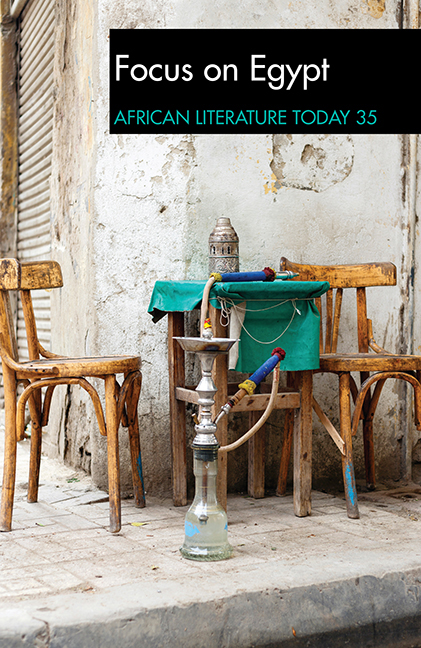Book contents
- Frontmatter
- Dedication
- Contents
- Notes on Contributors
- Foreword
- EDITORIAL ARTICLE
- ARTICLES
- FEATURED ARTICLES
- LITERARY SUPPLEMENT
- TRIBUTE
- REVIEWS
- Mohammad Rabie, Otared. Translated from Arabic By Robin Moger
- Yasser Abdel Hafez, The Book of Safety. Translated from Arabic to English by Robin Moger
- Sanya Osha, On A Sad Weather-Beaten Couch
- Adam Mayer, Naija Marxism: Revolutionary Thought in Nigeria
- NoViolet Bulawayo, We Need New Names
- Okey Ndibe, Never Look An American in the Eye: Flying Turtles, Colonial Ghosts, and the Making of a Nigerian American
- Reviews of Nigerian Poetry
Yasser Abdel Hafez, The Bookof Safety. Translated from Arabic to English byRobin Moger
from REVIEWS
Published online by Cambridge University Press: 24 August 2019
- Frontmatter
- Dedication
- Contents
- Notes on Contributors
- Foreword
- EDITORIAL ARTICLE
- ARTICLES
- FEATURED ARTICLES
- LITERARY SUPPLEMENT
- TRIBUTE
- REVIEWS
- Mohammad Rabie, Otared. Translated from Arabic By Robin Moger
- Yasser Abdel Hafez, The Book of Safety. Translated from Arabic to English by Robin Moger
- Sanya Osha, On A Sad Weather-Beaten Couch
- Adam Mayer, Naija Marxism: Revolutionary Thought in Nigeria
- NoViolet Bulawayo, We Need New Names
- Okey Ndibe, Never Look An American in the Eye: Flying Turtles, Colonial Ghosts, and the Making of a Nigerian American
- Reviews of Nigerian Poetry
Summary
At the heart ofYasser Abdel Hafez's novel The Book ofSafety is a mystery: what drove Mustafa Ismail,one of the main characters in the novel, to abandon his jobas a professor and engage in breaking into the homes ofwealthy people. Was he motivated by greed, revenge, somecombination thereof or something else? Various theories arepresented throughout the novel to explain his motivationswhich the reader will have to evaluate for himself.
This is a novelof ideas in the vein of Julio Cortazar'sHopscotch where most of the charactersare of the intellectual type and are trying to make sense oftheir own thoughts, desires, and the deteriorating situationin their city – Cairo. But despite the preponderance ofideas, the novel is not a mere vehicle for presenting ideasbut is populated by characters with distinct andrecognizable personalities.
Among thesepersonalities is Nabil Adli (the interrogator of MustafaIsmail) and Khaled Mamoun (the transcriber of theinterrogations). The relationships between these charactersas well as others who are less central to the novel arecomplex and hard to pin down. Many of these relations veerbetween polar opposites of desire and denial, obedience anddefiance, passion and rejection.
The ambiguityis not just in the relations between the characters butextends to attitudes towards history, nationalism, science,the supernatural and other topics. No subject seems to beoff limits. The novel, however, is less concerned withdescriptions of life in contemporary Cairo than indeconstructing it – a measure of how far the Egyptian novelhas come since the days of Naguib Mahfouz's realistnovels.
Perhaps as partof the postmodernist urge to avoid linearity, the charactersjump from one idea to another, one subject to another, neverlingering on one topic for too long, giving a disjointed andincomplete picture of whatever they are discussing andleaving it to the reader to try and complete the picture, ifhe or she, can.
The novel seemspreoccupied with reflections on the nature of art,specifically writing and photography and the boundariesbetween reality and fiction. It is full of puzzles,paradoxes, and mind-games. As part of this preoccupationwith aesthetics, even the places where the novel takes placehave eye-catching titles such as the Palace of Confessions,the Cafe of Lunatics, the Lotus House, and Sappho (abookstore).
- Type
- Chapter
- Information
- ALT 35: Focus on EgyptAfrican Literature Today 35, pp. 283 - 286Publisher: Boydell & BrewerPrint publication year: 2017

